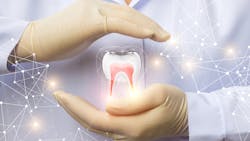Do you really know what oral-systemic means?
Who coined the phrase “oral-systemic health”? I couldn’t find the person, but good golly, it’s not a quick, easy, or understandable turn of phrase.
Ask a layperson or non-oral health-care provider “What is oral-systemic health?” and listen to their answer. Oof! Their lack of knowledge provides us an opportunity.
So, what is it?
We as oral medicine professionals should have a good grasp of what oral-systemic health really means. Defining the two terms, “oral” means of relating to the mouth, and “systemic” means pertaining to or affecting whole-body health and the state of being free from illness or injury.
In a 2019 study, 93% of the dentists responded that “oral health is associated with systemic health.”1 Unfortunately, the depth of their knowledge can be deficient. We may know there are general connections, but we should know exactly what they are.
The tricky part is that research is being shared every day and it’s impossible for us to keep up. Dental and dental hygiene schools have a finite amount of time to teach everything they deem important, and there lies one of the challenges—no time to educate about oral-systemic health.
Related reading:
- The medical-dental-patient gap: Building relationships for optimal patient outcomes
- Lessons from global survey data: What else can dental hygienists do to close the periodontal disease prevention gap?
Adding new graduates to the hundreds of thousands of existing providers who are not aware of the intricacies of the connections make our industry wrought with misunderstanding and frankly, a lack of knowledge. Expecting the public and medical professionals to understand is unrealistic. If we’re clear about the link of oral health to systemic disease and the oral manifestations of systemic disease, the collaboration between us and other health-care professionals would greatly improve.
The problem is three-fold—our knowledge, the knowledge of health-care professionals, and the public’s knowledge. Sadly, in 2012 a study showed that two thirds of patients with chronic periodontal disease were unaware of the association between periodontal therapy and systemic disease.2
As I wrote this article, I had high hopes that this had changed during the last decade, but more recent research in 2021 concluded that there is “lack of awareness and an ignorant attitude about the bidirectional relationship between cardiovascular disease (CVD) and periodontitis among the CVD patients.”3
Twenty years ago, the Surgeon General said that oral health is essential to overall health and well-being. There were several specific conclusions, but a couple resonated with me. “Many systemic diseases and conditions, as well as treatments for such conditions, have important oral manifestations; conversely, oral infections may place many individuals at greater risk for morbidity from a variety of causes.”4 Another item of interest was the concern for our system of educating providers and delivering appropriate care to the population.4 This came out 20 years ago!
In the last two decades, the effects of periodontal disease have been well studied in relationship to 57 adverse health conditions.5 Quite simply, there have been three pathways linking oral infections to systemic effects: 1) metastatic spread of infection as a result of transient bacteremia, 2) the injury from circulating oral toxins, and 3) inflammation caused by oral microorganisms.
Specific related conditions
The relationship between diabetes and periodontal disease is seen as bidirectional.6 Hyperglycemia affects oral health and periodontitis affects glycemic control. In 2019, 37.3 million Americans, more than 11% of the population, had diabetes. Of those, 8.5 million were undiagnosed.7
Periodontal disease and CVD have been studied in depth.8,9 The periodontal pathogen burden has been linked with acute coronary syndrome (ACS) and subclinical atherosclerosis.10,11,12 Streptococcus sanguinis moves from the oral cavity to the bloodstream, colonizes the cardiac endothelium, and is a risk factor for infective endocarditis.13,14
Rheumatoid arthritis and poor pregnancy outcomes have also been well researched,15,16 as has human papillomavirus (HPV). If HPV infects the mouth, patients are at a greater risk for mouth and throat cancers. Lastly, neurodegenerative diseases such as Alzheimer’s and Parkinson’s have associations with the oral microbiome.17,18,19
In the coming months I will distill the research and related information about the oral-systemic link so that we as an industry can have the tools to not only equip ourselves but help our patients have longer and healthier lives. I often use the idiom, “It takes a village.” We must cooperate to achieve what is best for our patients and that includes sharing knowledge in an area that most of us did not learn about in school. Our new education will give us the ability to share and reach health-care providers and the public more easily. When our patients and other medical providers understand the link, this may have an impact on access to oral care that is so desperately needed.
Editor’s note: This article appeared in the May 2022 print edition of RDH magazine and has been updated as of April 2025. Dental hygienists in North America are eligible for a complimentary print subscription. Sign up here.
References
- Nazir MA, Izhar F, Akhtar K, Almas K. Dentists' awareness about the link between oral and systemic health. J Family Community Med. 2019;26(3):206-212. doi:10.4103/jfcm.JFCM_55_19
- Bhatia A, Bains SK, Singh MP. To assess knowledge and awareness of North Indian population towards periodontal therapy and oral‑systemic disease link: A cross‑sectional survey. J Interdiscip Dent. 2013;3:79. doi:10.4103/2229-5194.126865
- Bawankar PV, Kolte AP, Kolte RA. Assessment of knowledge, awareness, and attitude among patients with cardiovascular disease about its association with chronic periodontitis [published correction appears in J Indian Soc Periodontol. 2021;25(3):270]. J Indian Soc Periodontol. 2021;25(2):156-161. doi:10.4103/jisp.jisp_101_20
- Oral Health in America. National Institute of Health. December 2021. https://www.nidcr.nih.gov/sites/default/files/2021-12/Oral-Health-in-America-Executive-Summary.pdf
- Monsarrat P, Blaizot A, Kémoun P, et al. Clinical research activity in periodontal medicine: a systematic mapping of trial registers. J Clin Periodontol. 2016;43(5):390-400. doi:10.1111/jcpe.12534
- Stanko P, Izakovicova Holla L. Bidirectional association between diabetes mellitus and inflammatory periodontal disease. A review. Biomed Pap Med Fac Univ Palacky Olomouc Czech Repub. 2014;158(1):35-38. doi:10.5507/bp.2014.005
- Statistics About Diabetes. American Diabetes Association. https://www.diabetes.org/about-us/statistics/about-diabetes
- Priyamvara A, Dey AK, Bandyopadhyay D, et al. Periodontal Inflammation and the risk of cardiovascular disease. Curr Atheroscler Rep. 2020;22(7):28. doi:10.1007/s11883-020-00848-6
- Carrizales-Sepúlveda EF, Ordaz-Farías A, Vera-Pineda R, Flores-Ramírez R. Periodontal disease, systemic inflammation and the risk of cardiovascular disease. Heart Lung Circ. 2018;27(11):1327-1334. doi:10.1016/j.hlc.2018.05.102
- Spahr A, Klein E, Khuseyinova N, et al. Periodontal infections and coronary heart disease: role of periodontal bacteria and importance of total pathogen burden in the coronary event and periodontal disease (CORODONT) study. Arch Intern Med. 2006;166(5):554-559. doi:10.1001/archinte.166.5.554
- Renvert S, Pettersson T, Ohlsson O, Persson GR. Bacterial profile and burden of periodontal infection in subjects with a diagnosis of acute coronary syndrome. J Periodontol. 2006;77(7):1110-1119. doi:10.1902/jop.2006.050336
- Andriankaja O, Trevisan M, Falkner K, et al. Association between periodontal pathogens and risk of nonfatal myocardial infarction. Community Dent Oral Epidemiol. 2011;39(2):177-185. doi:10.1111/j.1600-0528.2010.00582.x
- Martini AM, Moricz BS, Ripperger AK, et al. Association of novel Streptococcus sanguinis virulence factors with pathogenesis in a native valve infective endocarditis model. Front Microbiol. 2020;11(1):10. doi:10.3389/fmicb.2020.00010
- Zhu B, Macleod LC, Kitten T, Xu P. Streptococcus sanguinis biofilm formation and interaction with oral pathogens. Future Microbiol. 2018;13(8):915-932. doi:10.2217/fmb-2018-0043
- Kaur S, Bright R, Proudman SM, Bartold PM. Does periodontal treatment influence clinical and biochemical measures for rheumatoid arthritis? A systematic review and meta-analysis. Semin Arthritis Rheum. 2014;44(2):113-122. doi:10.1016/j.semarthrit.2014.04.009
- Ide M, Papapanou PN. Epidemiology of association between maternal periodontal disease and adverse pregnancy outcomes—systematic review. J Periodontol. 2013;84(4 Suppl):S181-S194. doi:10.1902/jop.2013.134009
- Dominy SS, Lynch C, Ermini F, et al. Porphyromonas gingivalisin Alzheimer's disease brains: Evidence for disease causation and treatment with small-molecule inhibitors. Sci Adv. 2019;5(1):eaau3333. doi:10.1126/sciadv.aau3333
- Mihaila D, Donegan J, Barns S, et al. The oral microbiome of early-stage Parkinson's disease and its relationship with functional measures of motor and non-motor function. PLoS One. 2019;14(6):e0218252. doi:10.1371/journal.pone.0218252
- Ranjan R, Abhinay A, Mishra M. Can oral microbial infections be a risk factor for neurodegeneration? A review of the literature. Neurol India. 2018;66(2):344-351. doi:10.4103/0028-3886.227315
About the Author

Anne O. Rice, BS, RDH, CDP, FAAOSH
Anne O. Rice, BS, RDH, CDP, FAAOSH, founded Oral Systemic Seminars after over 35 years of clinical practice and is passionate about educating the community on modifiable risk factors for dementia and their relationship to dentistry. She is a certified dementia practitioner, a longevity specialist, a fellow with AAOSH, and has consulted for Weill Cornell Alzheimer’s Prevention Clinic, FAU, and Atria Institute. Reach out to Anne at anneorice.com.
